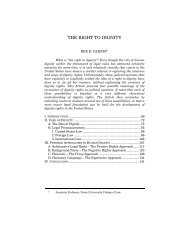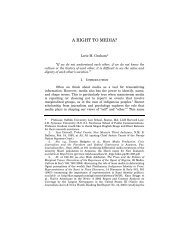Inmate Grievance Procedures - Columbia Law School
Inmate Grievance Procedures - Columbia Law School
Inmate Grievance Procedures - Columbia Law School
- No tags were found...
You also want an ePaper? Increase the reach of your titles
YUMPU automatically turns print PDFs into web optimized ePapers that Google loves.
366 INMATE GRIEVANCE PROCEDURES Ch. 15Within seven calendar days after you receive a written recommendation from the IGRC, you can appealto the Superintendent. The appeal will follow the procedure described in Part E(1)(c) of this chapter. If youdo not file an appeal within seven calendar days, you are presumed to have accepted the recommendation. 127Within seven calendar days of receiving the Superintendent’s response, you can appeal to the CORC. 128The appeal will follow the procedure described in Part E(1)(d) of this chapter.3. Directive 4002: The <strong>Inmate</strong> Liaison CommitteeThe Superintendent in your facility must establish an ILC. 129 This committee’s goal is to provideeffective communication between prisoners and the administration, and to promote the accurate distributionand exchange of information. The ILC must discuss the prisoners’ general welfare with prison officials. Thisincludes, for example, suggestions from prisoners on facility operations. These discussions may not relate tospecific problems of individual prisoners. The Superintendent and Facility Executive Team will meet withthe ILC monthly, and informal discussions should occur consistently.The ILC is made up of a group of prisoners chosen by the general population. Representatives are electedby secret ballot for a term of six months and may serve for two terms in a row. The ILC will elect officers andan executive committee who can serve for one six month term per year. The Superintendent can denymembership to prisoners with recent or ongoing disciplinary problems. 130The ILC must have a room with facilities, including a typewriter, desks, supplies, and stationery. 131 TheILC will be governed by a Constitution and By-<strong>Law</strong>s, which it will prepare with the help of a staff member.A suggested format for the Constitution and By-<strong>Law</strong>s is attached to Directive 4002. 132F. Rules for <strong>Inmate</strong> <strong>Grievance</strong> <strong>Procedures</strong> in Other StatesIn 1979, Congress set out minimum standards for formal inmate grievance procedures to help reduce thelarge number of prisoner civil rights cases that were waiting to be heard in courts. 133 States with grievanceprocedures that meet these standards are certified by the Attorney General. 134 Remember, you must exhaustall available administrative procedures before you can file a claim under 42 U.S.C. § 1983. 135In order for an inmate grievance procedure to be certified, the state must meet certain federal minimumstandards for the communication of those procedures to all prisoners. 136 One of the requirements set out byCongress is that all IGPs must be published. A certified inmate grievance procedure must also be readilyavailable to all prisoners and employees of the institution. Every prisoner and employee must receivewritten notification of the procedure when they get to the institution. You must also be given a verbalexplanation of the procedure and the opportunity to ask questions about the procedure at that time. Theprocedure must be written in any language that is spoken by a significant portion of the prison population.Provisions must be made to aid prisoners who speak other languages, as well as for those with disabilities.In general, you should be able to find guidelines and procedures for filing a grievance in your prison lawlibrary. Ask your librarian if you need help finding them. It is important for you to understand these rulesbefore filing your grievance to make the best use of the grievance procedure.127. N.Y. Comp. Codes R. & Regs. tit. 7, § 702.4(b)(1) (2007); State of New York, Department of CorrectionalServices, Directive No. 4041, <strong>Inmate</strong> <strong>Grievance</strong> Program Modification Plan § 702.4(b)(1) (2007).128. N.Y. Comp. Codes R. & Regs. tit. 7, § 702.4(c)(1) (2007); State of New York, Department of CorrectionalServices, Directive No. 4041, <strong>Inmate</strong> <strong>Grievance</strong> Program Modification Plan § 702.4(c)(1) (2007).129. State of New York, Department of Correctional Services, Directive No. 4002, <strong>Inmate</strong> Liaison Committee §II(A) (1997) (as revised Sept. 21, 2006).130. State of New York, Department of Correctional Services, Directive No. 4002, <strong>Inmate</strong> Liaison Committee §II(B)(5) (1997) (as revised Sept. 21, 2006).131. State of New York, Department of Correctional Services, Directive No. 4002, <strong>Inmate</strong> Liaison Committee §II(E) (1997) (as revised Sept. 21, 2006).132. State of New York, Department of Correctional Services, Directive No. 4002, <strong>Inmate</strong> Liaison Committee §II(F) (1997) (as revised Sept. 21, 2006).133. S. Rep. No. 96-416, at 34 (1979), as reprinted in 1980 U.S.C.C.A.N. 787, 816. The minimum standards forinmate grievance procedures can be found at 28 C.F.R. §§ 40.1–40.10 (2010).134. 42 U.S.C. § 1997e (2000). The procedures for obtaining certification of a grievance procedure can be found at28 C.F.R. §§ 40.11–40.22 (2009).135. 42 U.S.C. § 1997e(a) (2000). See Chapter 16 of the JLM for more information on § 1983 claims.136. 28 C.F.R. § 40.11(b) (2009). For a detailed description of how these procedures must be communicated, see 28C.F.R. § 40.3 (2009).















